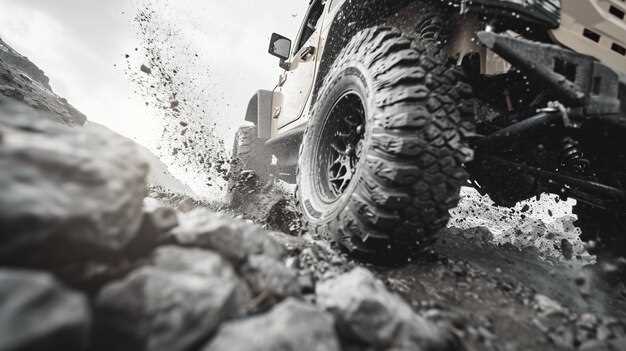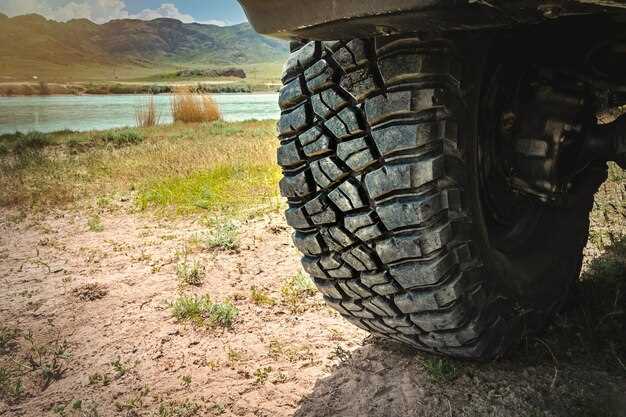
When it comes to enhancing your vehicle’s performance both on and off-road, choosing the right tires is crucial. This review focuses on the top five all-terrain tires that seamlessly blend daily driving capabilities with rugged trail performance. These tires are designed to tackle diverse driving conditions, ensuring you remain safe and comfortable regardless of the environment.
Whether you are navigating city streets or exploring unpaved paths, the right set of all-terrain tires can make a significant difference. They provide a unique combination of traction, durability, and comfort, making them suitable for adventurous spirits who also require reliability in their everyday commute. In this review, we will highlight the key features, pros, and cons of each tire, enabling you to make an informed decision tailored to your driving needs.
Join us as we explore these top contenders, each engineered to endure the challenges posed by both asphalt and off-road trails. Get ready to elevate your driving experience with the best all-terrain tires on the market today!
Top Features to Look for in All-Terrain Tires

When selecting all-terrain tires, there are several key features that can greatly influence performance on both daily drives and off-road trails. Understanding these features will help in making an informed choice.
- Tread Design: A good tread pattern is crucial for all-terrain tires. Look for a combination of large, aggressive treads for off-road grip and tighter patterns for on-road stability.
- Compound Quality: The rubber compound affects durability and traction. Opt for tires made from high-quality materials that balance flexibility with resistance to wear and tear.
- Sidewall Strength: All-terrain tires should have reinforced sidewalls to resist punctures and abrasions when navigating rocky terrains. A tough sidewall enhances durability in rough conditions.
- Load Capacity: Ensure the tires you choose can handle the weight of your vehicle and any additional loads. Check the load rating to find a suitable option for your needs.
- Noise Level: All-terrain tires can generate noise on paved roads. Look for a design that minimizes road noise while still providing excellent traction off-road.
Choosing all-terrain tires with these features will enhance your driving experience, whether you’re commuting in the city or tackling challenging trails.
Comparative Review of the Best All-Terrain Tires
When choosing the right all-terrain tires for daily driving and off-road trails, it’s essential to consider performance, durability, and versatility. This review will focus on five top-rated options that excel in both environments.
The first tire worth mentioning is the Goodyear Wrangler All-Terrain Adventure. Known for its robust construction and impressive traction, this tire features a unique tread design that enhances grip on various surfaces. Its reinforced sidewalls provide added protection against punctures, making it suitable for rugged trails.
Next is the Michelin LTX A/T2, which provides an exceptional balance between on-road comfort and off-road capabilities. With its innovative tread pattern, it delivers excellent handling and braking performance, while also offering a quiet ride on highways. The LTX A/T2 is a reliable option for those who spend most of their time on paved roads but still want to venture off the beaten path.
The BFGoodrich All-Terrain T/A KO2 is another strong contender. Renowned for its excellent traction in all weather conditions, this tire boasts aggressive shoulder tread and a rugged design. It performs effectively in mud and snow while providing reliable handling on dry surfaces. Its durability is a significant advantage for off-road enthusiasts.
Another standout is the Falken Wildpeak AT3W. This tire excels in wet and dry conditions, thanks to its strategically designed grooves that channel water away. Additionally, it offers remarkable off-road performance with enhanced grip on rocky surfaces. The Wildpeak AT3W’s all-weather capabilities make it an appealing choice for varying driving conditions.
Lastly, the Nitto Terra Grappler G2 combines style with function. With a modern tread design, it ensures a quiet ride and solid performance on highways. Off-road, it proves capable with its aggressive traction. The Terra Grappler G2 is designed to meet the needs of versatile drivers who require both on-road comfort and off-road prowess.
In conclusion, each of these all-terrain tires offers a unique set of features tailored for different driving needs. The choice ultimately depends on individual preferences related to terrain exposure, driving habits, and performance expectations. This review provides a solid foundation for making an informed decision regarding all-terrain tires.
How All-Terrain Tires Impact Fuel Efficiency
When considering the best all-terrain tires for daily driving and trails, it’s essential to understand their influence on fuel efficiency. All-terrain tires are designed to perform well on various surfaces, but this versatility can come with trade-offs in fuel consumption.
Here are a few key factors to consider regarding all-terrain tires and their effect on fuel efficiency:
- Tread Design: The aggressive tread patterns on all-terrain tires enhance off-road traction but can also increase rolling resistance on paved roads. This resistance can lead to decreased fuel efficiency compared to standard highway tires.
- Weight: All-terrain tires are often heavier than regular tires. Increased weight can result in higher energy consumption, consequently affecting fuel economy. This factor is particularly important for daily drivers who prioritize efficiency.
- Air Pressure: Maintaining optimal air pressure in all-terrain tires is crucial for fuel efficiency. Under-inflated tires can lead to increased rolling resistance, resulting in additional fuel consumption.
- Driving Habits: The way a vehicle is driven–such as rapid acceleration and hard braking–can have a more significant impact on fuel efficiency than the type of tires alone. All-terrain tires can exacerbate inefficiencies if not driven judiciously.
To optimize fuel efficiency while using all-terrain tires, consider these practical tips:
- Regularly check and maintain tire pressure to ensure it meets the manufacturer’s recommendations.
- Choose all-terrain tires that offer a balance between off-road capability and on-road performance.
- Avoid aggressive driving behaviors that can lead to unnecessary fuel consumption.
- Monitor tread wear to ensure your tires are performing efficiently.
In conclusion, while all-terrain tires provide versatility for different driving conditions, they can impact fuel efficiency. By understanding their characteristics and making informed choices, drivers can enjoy the benefits of all-terrain tires without significantly compromising their vehicle’s fuel economy.
Performance on Wet and Dry Surfaces: What to Expect

When selecting all-terrain tires for both daily driving and off-road adventures, understanding their performance on various surfaces is crucial. In this review, we will explore the capabilities of these versatile tires in wet and dry conditions.
On dry surfaces, all-terrain tires typically excel thanks to their robust tread patterns designed for increased traction and stability. The combination of a wide contact patch and durable rubber compounds allows for confident handling during acceleration and braking. Drivers can expect enhanced cornering grip, which makes a significant difference when navigating city streets or winding trails.
In contrast, performance on wet surfaces is where all-terrain tires may encounter challenges. Many models incorporate larger voids and deeper lugs that assist in channeling water away, thereby reducing hydroplaning risk. However, it’s essential to choose tires specifically designed with enhanced siping and tread designs to improve grip on slippery roads. Proper maintenance, such as regular rotation and alignment checks, can also influence how well tires perform in rain-drenched conditions.
Overall, all-terrain tires present a balanced approach to both wet and dry driving. While they aim to provide versatility, drivers should carefully consider the specific tread design and compound characteristics when making a selection. This nuanced understanding will ensure optimal performance, safety, and control on varying surfaces.
Longevity and Wear: Evaluating Tire Lifespan
When choosing the best all-terrain tires for both daily driving and off-road trails, assessing their longevity and wear is crucial. The lifespan of a tire is influenced by a combination of factors, including compound materials, tread design, and usage patterns. A well-informed review of these elements can help consumers make the right choice for their specific needs.
The tread composition is one of the primary determinants of a tire’s longevity. High-quality all-terrain tires often utilize advanced rubber compounds that enhance durability and reduce wear. These materials are engineered to withstand the challenges posed by various terrains, ensuring that the tires maintain their integrity over time. Consumers should look for tires with proven durability ratings and consider manufacturer warranties as an indication of expected lifespan.
Tread design plays a significant role in how tires wear. All-terrain tires typically feature a more aggressive tread pattern than standard road tires, allowing for better traction on uneven surfaces. However, this design can also lead to uneven wear if the tires are frequently used on paved roads. Regular rotation can mitigate this issue, extending the lifespan of the tires while ensuring optimal performance across different driving conditions.
Furthermore, driving habits greatly impact tire wear. Aggressive driving, such as rapid acceleration and hard braking, can accelerate tread depletion. Regular maintenance, including proper inflation and alignment checks, is essential for maximizing tire life. A well-maintained tire can significantly outperform its poorly maintained counterpart, highlighting the importance of following manufacturer guidelines for care.
Finally, it’s important to consider the expected mileage provided by various all-terrain tire models. Reviews that include real-world test results offer valuable insights into how long a tire may last under specific conditions. Many manufacturers provide mileage warranties, which can serve as useful benchmarks when evaluating potential purchases. In conclusion, by focusing on tread composition, design, maintenance practices, and comprehensive reviews, consumers can make informed decisions that enhance the longevity and wear resistance of their all-terrain tires.
Price vs. Value: Finding the Right All-Terrain Tire
When considering all-terrain tires, it’s essential to differentiate between price and value. While price reflects the cost of a tire, value encompasses its performance, durability, and suitability for both daily driving and off-road trails. This distinction is crucial for making an informed decision that aligns with your needs and budget.
All-terrain tires often come with a range of prices, influenced by brand reputation, materials used, and specific features designed for various driving conditions. A higher price tag doesn’t always guarantee better performance; therefore, reviewing each tire’s specifications and user feedback can provide insights into its actual value.
To illustrate the comparison of price versus value, we can analyze a few popular all-terrain tire options based on their features, customer satisfaction, and pricing. The following table summarizes key aspects to consider:
| Tire Model | Price Range | Durability Rating | Performance on Trails | Customer Rating |
|---|---|---|---|---|
| Tire A | $150 – $200 | 8/10 | Excellent | 4.5/5 |
| Tire B | $120 – $170 | 7/10 | Good | 4.0/5 |
| Tire C | $200 – $250 | 9/10 | Outstanding | 4.8/5 |
| Tire D | $100 – $150 | 6/10 | Fair | 3.9/5 |
| Tire E | $180 – $220 | 8/10 | Very Good | 4.3/5 |
When evaluating the options, consider which features are most critical for your driving habits. For instance, if you frequently navigate rough terrains, investing in a tire with higher durability and superior off-road performance might justify the higher price. Conversely, for those primarily driving on highways, a more affordable option that offers decent performance could suffice.
Ultimately, finding the right all-terrain tire requires a careful assessment of both price and value. Prioritize features that align with your daily driving and trail needs to ensure an optimal balance between cost and comprehensive performance.
